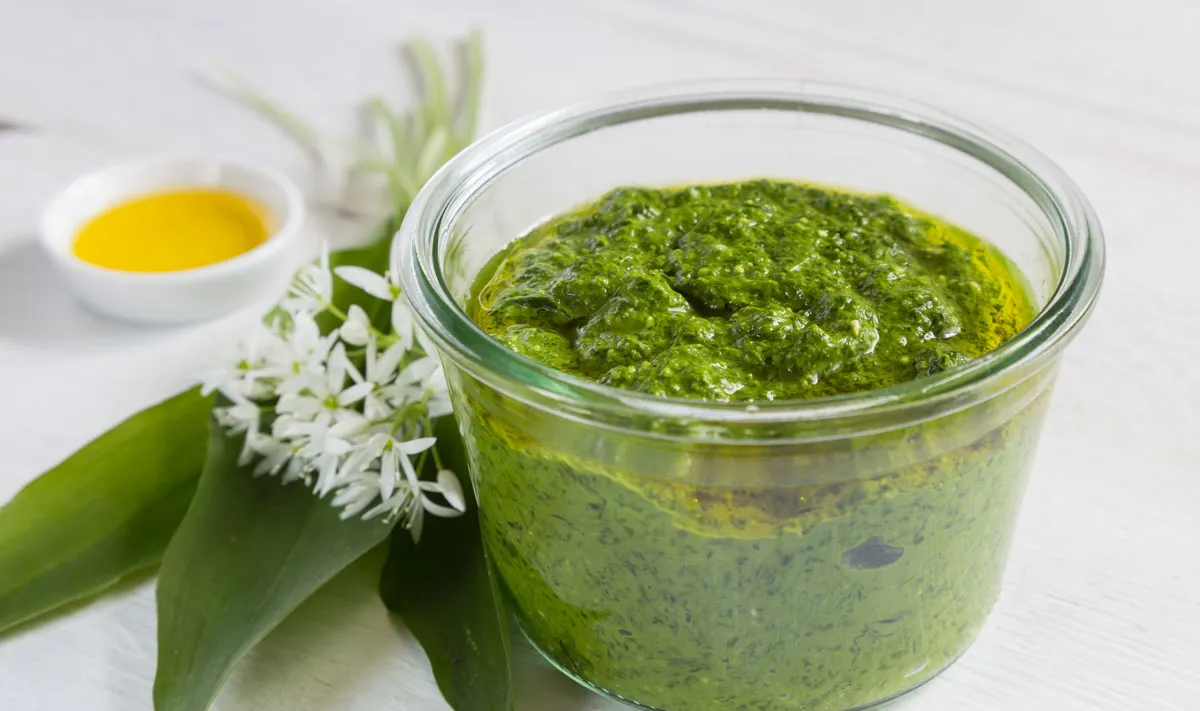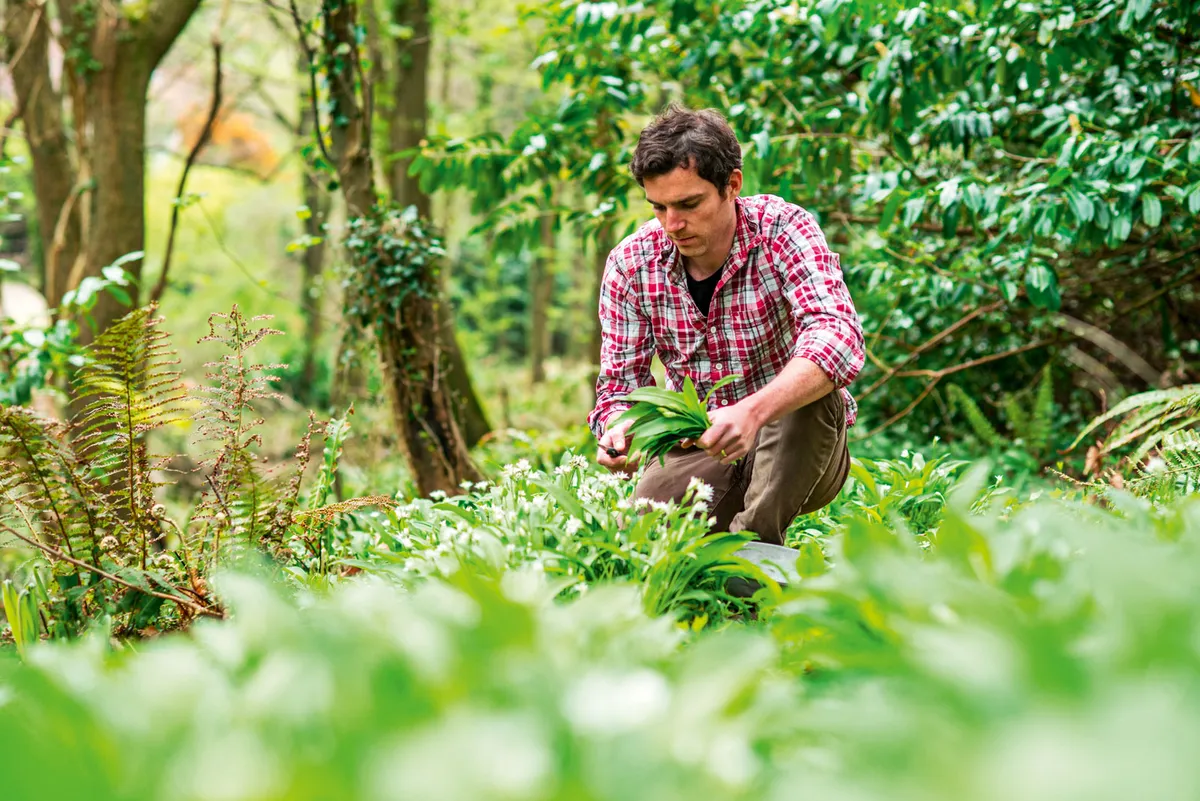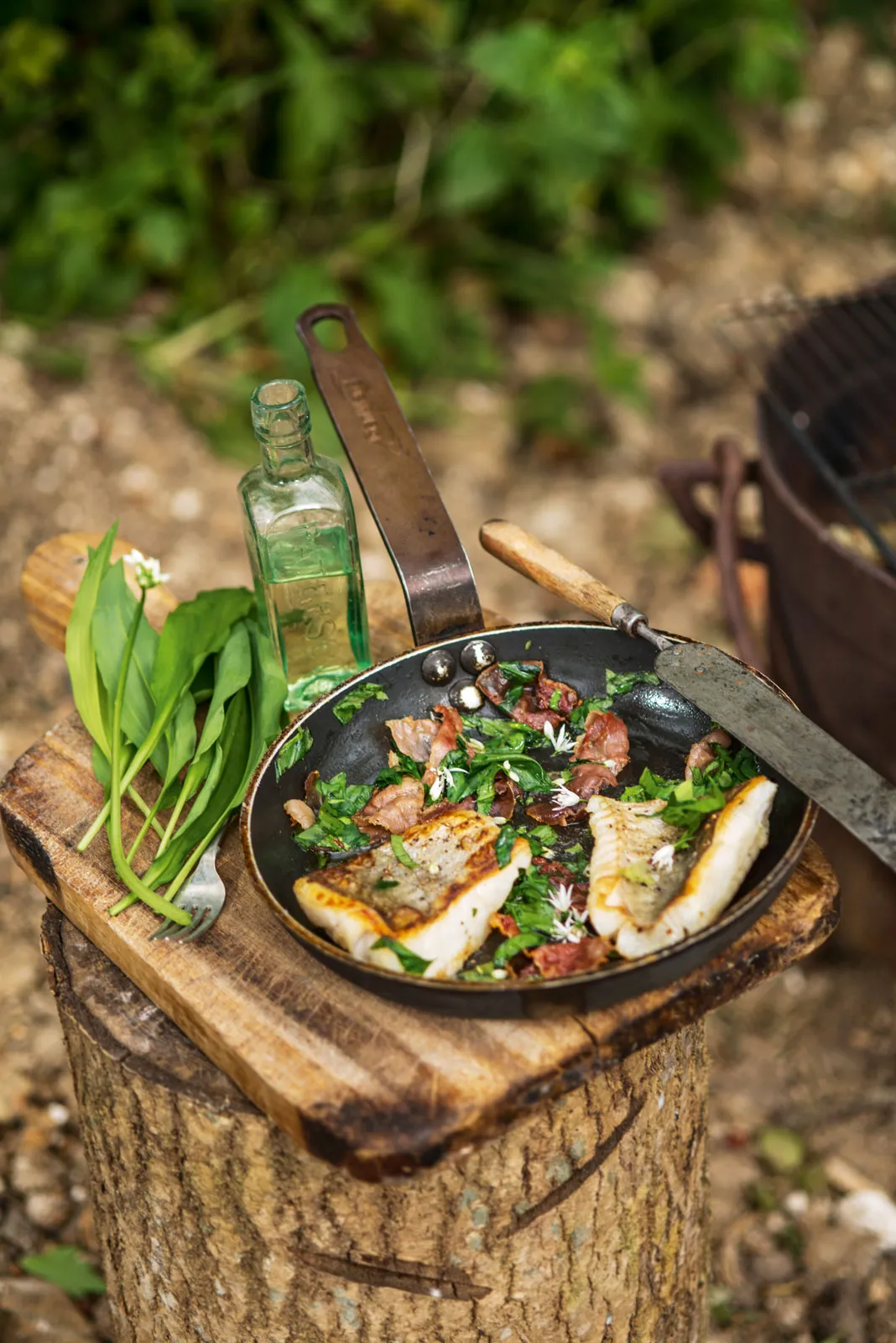With its fresh, garlicky smell, wild garlic (Allium ursinum) has an unmistakable scent in woodlands and forests in the spring months. Preferring to grow in shady and damp conditions, the wild garlic season starts in late winter and lasts until the end of spring, although it may be past its best by then.
Why not take a woodland walk and see if you can spot or smell any wild garlic? Just head to your local woodland, forest or riverbank. In our expert guide, learn facts about wild garlic, including how to forage for it in Britain, with a few key details regarding where it can be found, characteristics and easy wild garlic recipe ideas.
Later in the year, in early summer, you can forage for elderflower and make your own delicious elderflower cordial. Then, come late summer, make the most of the blackberry season and start rustling up crumbles and pies.
As wild garlic grows in abundance it is generally acceptable to pick a small amount, however our guide below explains how to pick wild garlic without causing any detrimental impact to the natural environment. The leaves can be eaten raw or cooked and can be blended to make a delicious wild garlic pesto to add to pasta, salads or soups.
What's the difference between wild garlic and regular garlic?
Wild garlic has a lighter flavour to traditional bulb garlic, and the green, pointed leaves and white flowers of this bulbous perennial flowering plant are easy to identify, making it a good first foray into foraging.
When is the wild garlic season?
The wild garlic plant, native to Britain, is also known as bear leek, bear's garlic, broad-leaved garlic, buckrams, ramsons or wood garlic and can grow to heights of between 45 and 50 cm.

The leaves and flowers are edible. Young leaves are delicious added to soups, sauces and pesto. Leaves appear in March and are best picked when young. The flowers emerge from April to June and can add a potent garlic punch to salads and sandwiches.

What does wild garlic look like?
Wild garlic grows in dense clumps, often carpeting woodland floors in the peak of the season. The vibrant green leaves are long and pointed with a smooth edge and are best picked when they are young. Wild garlic flowers form delicate white clusters and tend to bloom in mid spring. The flowers are also edible and can look pretty added to salads and other dishes.

What habitat does wild garlic grow in?
Dense clusters of green spears thrust from the woodland floor in spring: these are ramsons, better known as wild garlic and they are a sign that the woodland you are walking in is very old.
Closely related to onions and garlic, ramsons similarly grow from bulbs and give off a strong and attractive garlic smell. In continental Europe, the bulbs are thought to be a favourite food of brown bears, hence the plant’s scientific name Allium ursinum (bear leek).

How to forage for wild garlic responsibly
Always be sure you can positively identify any plant before you pick it, and never eat any plant you are unsure of. When foraging, ensure you leave plenty for wildlife.
Here are a couple of key foraging guidelines:
- Seek permission before foraging. In certain areas, plant species will be protected so it is important to do some research and check with the landowner before you start gathering.
- Only pick from areas that have a plentiful supply. Look for areas where you can find food in abundance and then only collect a small amount for personal use. Never completely strip an area as this could damage the species and deny another forager the chance to collect.
- Leave enough for wildlife and avoid damaging habitats. Many animals rely on plants for survival, so never take more than you plan to eat as this could also deny wildlife from a valuable food source. Be mindful about wildlife habitats and avoid disturbing or damaging.
- Never pick protected species or cause permanent damage. Britain’s wild plants are all protected under the Wildlife and Countryside Act (1981), which makes it illegal to dig up or remove a plant. Check the law before you forage or if in doubt, why not take part in a foraging class with an expert and learn the basics.
Where to find wild garlic
If you’re new to foraging then wild garlic is a great best place to start, as it’s very easy to identify, very prolific and delicious. At this time of year there is no need to buy garlic bulbs in the supermarket - their foraging counterpart can be found in any British woodland or riverbank.

Wild garlic likes damp ground where it will grow in abundance, with hundreds of green leaves growing on a single green stem. Your local woodland or riverside is a good place to look. It is preferable not to forage for wild garlic near a busy road as the exhaust fumes from vehicles can transfer into the plants.
Here is a small selection of some of the best places to see and to smell wild garlic in the UK:
- Arnos Vale, Bristol
- The Woods at Roseberry Topping, North Yorkshire
- Gribbin Head, Cornwall
- Rampsholme Island, Derwentwater, Cumbria

Many National Trust owned woodlands are full of wild garlic in the spring, here is a selection of our favourite National Trust woodlands for wild garlic – just remember to check before foraging.
- Prior Park, Bath
- Columbjohn, Killerton Estate, Devon
- Hardwick Hall, Derbyshire
What to do with wild garlic
Like the domesticated alliums, ramsons are edible and the leaves are an excellent addition to a cheese or pate sandwich. Carefully, pick a handful of leaves without uprooting the bulbs and blend or chop and use like garlic. You can also save the flowers as they make a beautiful edible decoration to savoury dishes.
Whizzed up with walnuts, olive oil and a few tablespoons of parmesan added after, the leaves also make a delicious wild garlic pesto.
Better still, you can create a lovely spring soup from the leaves. Fry an onion in butter until soft and add a finely cubed potato and a bay leaf. After another five minutes frying, add 500ml of vegetable stock and simmer until the potato is soft –about 10 minutes. Add the bunch of ramsons leaves and cook briefly – no more than a couple of minutes. Remove the bay leaf, blend the soup, add seasoning and you will have a bowl of spring green goodness.
Caution: be aware that wild garlic can look similar to a poisonous plant called lily of the valley. The main difference is the smell – wild garlic has a pungent smell of garlic. If in doubt, best not to pick or eat.

How to make wild garlic pesto

Turn your foraged finds into a delicious, vibrant pesto to enjoy this spring. Here is our easy recipe for wild garlic pesto which can be added to pasta, tarts, sandwiches or soups.
How to store wild garlic
Can you freeze wild garlic?
If you plan on cooking with your newly foraged wild garlic within a day or two after collecting, then it can be stored in an airtight container in the fridge. Alternatively, pop the stem in a glass of water and put in the fridge to help stay fresh for longer.

Similarly to frozen fruit or vegetables, wild garlic can be frozen to preserve its freshness and nutrients. Simply, wash and dry and place in a freezer bag and freeze. Another benefit freezing wild garlic this is you can cook with wild garlic out of season.
Wild garlic recipes
River Cottage chef Gill Meller has created four delicious wild garlic recipes to rustle up using your foraged finds.
Nothing signified the change in the season to my somewhat unreactive senses like the smell of wild garlic, as its emerald spears force up through the warming earth, sweeping over shaded patches of ground like a soft carpet of new green. The smell is still with me today as real and instant as it was then, triggering my sense memories in the same way each year.
Today I use wild garlic – or ramsons as they are also known – in my cooking throughout the plant’s short season, which runs from roughly March through to late June. The best of the crop is to be picked when it is still young. As a smaller, delicate plant, the flavour is light and clean. It can even be eaten in salads at this point. Big, heavier leaves can be less interesting, although they can still be cooked or dried.
Harvesting is easy and relatively fun, particularly with children in tow. It’s such a common plant, and in some areas it is more than abundant. Look for nice, tender, bright leaves. I use my sharp penknife to cut small bunches at the base of its stalk. It is possible to harvest the bulbs as well. This tubular structure is a modified leaf stem and very similar to our everyday bulb garlic, although if there is very little wild garlic in your patch it may be worth leaving the bulb in situ.
Late on in the season, the flowers can be picked and eaten, too. They’re great in salads but you can also cook them.
I’ve used wild garlic in all manner of recipes, from pesto to soup through to pastries, breads and curries. If you like garlic bread, then try chopping the leaf finely and folding through salted butter, before spreading on a thick slice of granary and toasting. I’ve included a few simple and totally delicious ways to use wild garlic in the following recipes.

Wild garlic, potato and chorizo tortilla
I really enjoy cooking through spring and early summer. It’s a pleasure, particularly if you’ve gone out and picked a little wild garlic beforehand, and this simple breakfast or lunch dish is no exception. Big flavours and easy to find ingredients make it a pretty, reliable, no-hassle fallback. Try making this earth and easy wild garlic, potato and chorizo tortilla — perfect for a light lunch.

Wild garlic and onion bhaji with wild garlic raita
These bhajis have become a River Cottage classic. They are cracking with a good curry or served with drinks as a little appetiser.

Pan fried pollock with ham and wild garlic

This recipe should appeal to those of you with a passion for fish cookery and the occasional woodland forage. I love using air-dried ham, which we make regularly at River Cottage, or you could use free-range or organic bacon.
Wild garlic bread sticks

This simple bread recipe, infused with foraged wild garlic, is a great option for family camping, says chef and food writer Gill Meller.
What are the health benefits of wild garlic?
Used traditionally throughout Europe as a spring tonic due to its blood-purifying properties, similarly to bulb garlic, wild garlic is also thought to lower cholesterol and blood-pressure, which in turn helps to reduce the risk of diseases such as heart attack or stroke.
Other uses for wild garlic
The leaves were once boiled and the resulting liquid used as a disinfectant. Its smell is said to repel cats, so may be a good inclusion for a keen ornithologist’s garden. Despite its strong scent, wild garlic has a much mellower taste than conventional garlic. Easily confused, prior to flowering, with the similarly leaved Lily of the Valley. Best not to eat this one though, it’s poisonous.
Main image: Wild garlic (Allium ursinum), also known as ramsons, growing in English coppiced woodland glade in rural Kent countryside/Getty Images





